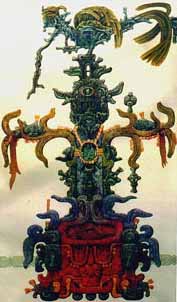
| FAMSI © 2002: Miguel Astor Aguilera |
||
Survey of Talking Cross Shrines in Yucatán and Quintana Roo
Research Year: 2000 Table of Contents
Abstract The "Talking" Cross is stated in the literature as having revealed itself, that is historically first appeared, during the Caste War of Yucatán in the 1850’s. What is of primary relevance today, beside the historical importance of the inception of the talking cross cult, is the meaning given these devices in the everyday lives of the "traditional" Yucatec-Maya people. In order to gauge the symbolism of the Maya cross, my ethnographic survey focused on Yucatec Maya villages that participate in what may be pre-Columbian pilgrimage routes (Konrad 1991) and have direct historical connections to the Caste War of 1847 (Bricker 1981). La Cruz "Parlante" se declara en la literatura como habiéndose revelado así misma, esto es como primero apareció históricamente, durante la Guerra de la Casta de Yucatán en los años 1850. Lo que hoy es de mayor relevancia, además de la importancia histórica del principio del culto de la cruz parlante, es el significado dado a estos dispositivos en la vida cotidiana de la gente "tradicional" Yucateca Maya. Para poder calibrar el simbolismo de la cruz Maya, mi estudio etnográfico se enfocó sobre los pueblos Yucatecas Mayas que participaron en lo que puede ser las rutas de perenigración precolombina (Konrad 1991) y tiene conexiones históricas directas a la Guerra de la Casta de 1847 (Bricker 1981). Click to download the report in PDF format: Survey of Talking Cross Shrines in Yucatán and Quintana Roo (750 KB) The PDF files require Adobe Acrobat Reader.
Submitted 01/01/2001 by: |
||
| Return to top of page | ||
|
Text links to all pages at this site are available at the FAMSI INDEX |
||

